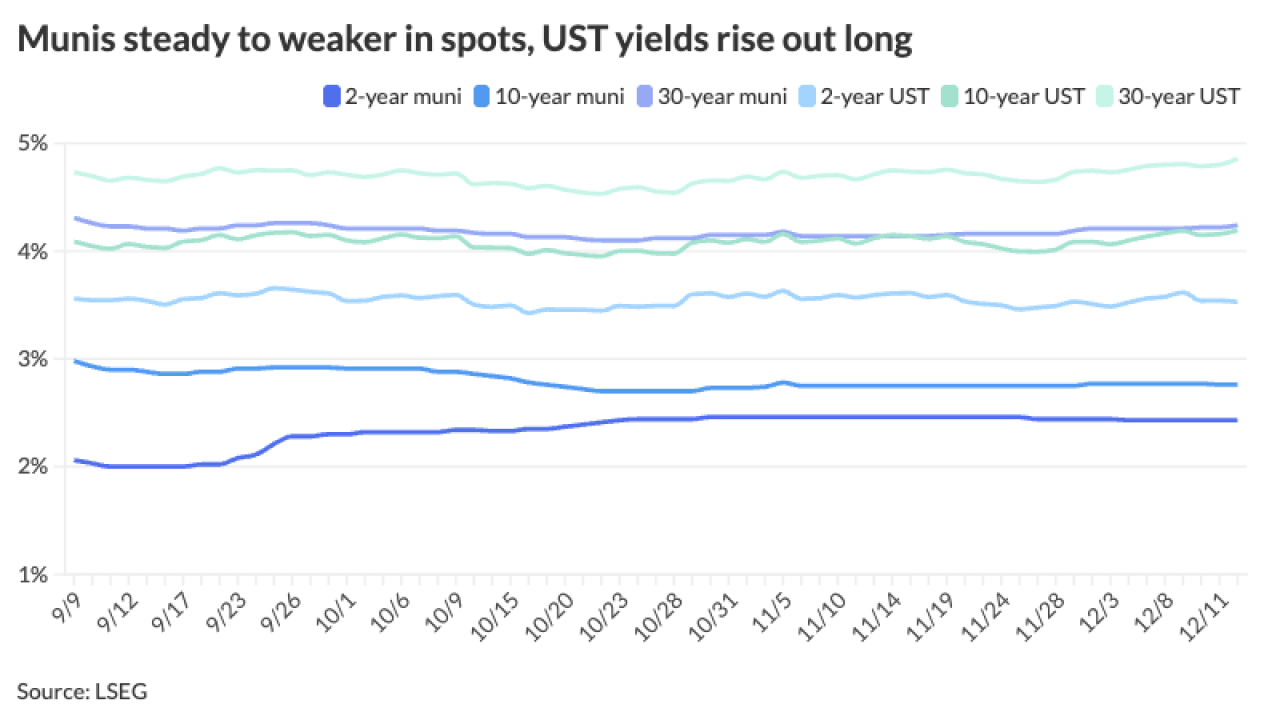
The past five years have been a strong period for municipal creditworthiness.
After the initial market swoon, the COVID-19 pandemic turned out to be a boon for state and local governments, based on the massive federal aid, robust sales and income tax collections and rising real estate values.
This "Golden Age of Public Finance," as it was called by industry pundits, is likely to face significant changes under the Trump administration. The combination of a new attitude toward the role of the federal government and a radical shift in international trade policy will have profound implications for municipal credit quality in the short to intermediate term.
The municipal bond tax exemption
The tax-exempt market's most immediate concern is, naturally, the potential loss of the federal tax exemption on municipal bond interest income, as Congress looks into every nook and cranny of the federal budget for ways to address the massive federal deficit and also pay for a significant tax relief program.
While a retroactive loss of the exemption appears unlikely, this issue does, at a minimum, hold worrisome implications for state and local governments' cost of capital going forward, at a time when infrastructure financing needs are projected to rise sharply.
The industry is mounting a spirited defense of the tax exemption under the leadership of trade associations such as the Bond Dealers of America.
Macroeconomic considerations
While the global trade crisis stemming from the recent tariff announcements is still unfolding and its ultimate result far from certain, we can already start thinking about its macro implications.
Should the current tariff regime persist for more than a few weeks, the general consensus among economists calls for a high inflation/slower growth scenario at best, or an actual recession scenario at worst.
Historically, municipal sectors that provide essential services such as K-12 education and utilities tend to hold up well under such doom and gloom economic scenarios. K-12 school districts are primarily funded by stable local property taxes. Utilities are inherently recession-resistant and, as a capital-intensive sector, may actually benefit from the decline in interest rates that result from slower growth.
That, however, may no longer be the case this time around. No fewer than 13 states are currently trying to cap or eliminate local property taxes. Some are looking to repeal their income tax. This potential shift to a more cyclically sensitive revenue mix cannot come at a worse time, as one can imagine.
A new federalism
To date, the new administration's approach to federal budget cuts has been nothing short of drastic, best described as a kind of "shock-and-awe zero-based budgeting," characterized by wholesale workforce layoffs and, in some cases, abolishment of entire agencies or departments.
While the recent pace of policy pivots can be dizzying, at least one common theme has emerged: "Move it back to the states."
This desire to decentralize many of the functions currently held by the federal government to the state level has been mentioned as the reason for a host of policy changes, from the potential elimination of the Federal Emergency Management Agency to the actual abolition of the Department of Education.
With state governments potentially gaining more control of their fiscal destinies, governance factors will assume even greater significance in any assessment of state creditworthiness.
There is one area where federal involvement is actually increasing: tying the awarding of major federal contracts to the administration's policy goals (more on this later).
Sectors on the frontline
While no area of public finance will be spared from the combination of sweeping federal budget cuts and trade policy changes, one can already identify a handful of sectors that might look vulnerable in the short term.
- Transportation: The most obvious victim of the new global trade war will be the ports sector, particularly port operators whose revenues are primarily driven by cargo volume and not by lease revenues. Major urban mass transit systems will become increasingly dependent on state subsidies. A global recession and/or rising animosity toward the U.S. may put a dent on the travel industry, with potentially negative impact on airlines and airport credits.
- Healthcare: Hanging over this sector are potential cuts in the Medicaid program and disruptions in the healthcare supply chain, mostly with China. Health systems with significant dependence on federal research contracts may also be vulnerable to funding cuts.
- Higher Education: Still recovering from the impacts of the pandemic, the sector is now navigating new federal policies that tie compliance with certain requirements to the awarding of federal contracts. The poster child for this latest crisis is Columbia University, accused of antisemitism for its handling of the recent on campus pro-Palestinian demonstrations.
Lastly, different areas of the country will be affected differently by federal workforce reductions. The assumption that laid off federal employees could be absorbed by the private sector may not be warranted if economic growth starts to falter.
"High yield/distressed" opportunities
Volatility always begets opportunities.
Already, we've seen some new distressed situations arise from the Administration's desire to reduce the real estate footprint of the federal government, notably bond financings that are backed by a lease from a federal agency through the General Service Administration.
The current value of these bonds vary based on the strength and duration of the underlying leases, as well as the vibrancy of the local office space market: the debt backed by a NASA lease are now trading at a deep discount to face value, as low as 55 cents on the dollar.
Climate risk
Aside from its direct and indirect impact on various sectors, the new federalism has also made climate risk much more difficult for market participants to ignore, particularly on the heels of the Los Angeles wildfires.
Up until recently, municipal investors have held on to the belief believed that all costs and damages from local natural disasters will be "federalized" through FEMA's disaster relief program. In fact, many affected localities ended up experiencing positive economic growth as a result of the massive injection of federal monies into the local economy.
This "security blanket" is about to be yanked away. The Trump administration has made clear its dissatisfaction with FEMA's effectiveness and, in keeping with its overall desire to downstream most current federal programs to the state level, has signaled its intent to abolish FEMA in favor of a block grant program to states.
Needless to say, assuming such a transition can be implemented smoothly, the absence of a federal coordinating presence may impact the timeliness and flow of disaster relief funds to affected areas. This further implies that the post-disaster hit on local economic activities could drag on longer than expected as rebuilding efforts get delayed.
Preventive climate resilience programs, such as the Building Resilient Infrastructure and Communities grants are also being de-funded by FEMA acting Administrator Cameron Hamilton as being biased toward long term climate change rather than providing immediate relief to disaster victims.
The upshot for municipal investors: you can no longer rely on the federal government to mitigate the immediate damages from natural disasters in the immediate aftermath of any climate event. Best to start incorporating climate risk into your credit assessment process.
As more states, such as Florida and California, increasingly become property insurers of last resort, municipal analysts who cover those states may have to enhance their knowledge of the property insurance and reinsurance markets, in order to properly gauge the actuarial soundness of state-funded programs such as California's FAIR plan.
Credit selection and risk management
A period of significant federal policy volatility, with multiple moving parts, can be a challenge for municipal analysts to decipher.
While the market has been somewhat sanguine about municipal creditworthiness in recent years, and for good reasons, it can no longer afford such complacency.
Now is the time to arm yourself with the latest credit analytics tools. At the end of the day, disciplined risk management practices and an informed credit selection process can help market participants navigate through market volatility and mitigate downside risk.





